I think this is probably an X Y problem, so I'll give some background info first.
I am building an app that can show a "form". The user can fill in the form with some stuff and create some custom things.
I think the most suitable thing to do is to use a table view for the form. And I can display all the text boxes that need to be fill in, in each of the table cells.
Here's a screenshot:
The "Add New Input" button will insert a new cell on the bottom when it is tapped. And if you swipe one of the inputs to the left, you get a "Delete" button. You can use that to delete the input.
As you can see, this table view needs to add and delete rows.
Originally, I was using a cocoapod called "TableViewModel" which makes this super easy. But then I found a really severe bug in the library so I don't want to use it anymore.
I tried using the table view's deleteRowsAtIndexPaths and insertRowsAtIndexPaths methods. But if I do it like this:
override func numberOfSectionsInTableView(tableView: UITableView) -> Int {
return 1
}
override func tableView(tableView: UITableView, numberOfRowsInSection section: Int) -> Int {
return 1
}
override func tableView(tableView: UITableView, cellForRowAtIndexPath indexPath: NSIndexPath) -> UITableViewCell {
let cell = UITableViewCell()
cell.textLabel?.text = "Hello"
return cell
}
// I use motionEnded here because I don't want to add a button or anything just to test this
override func motionEnded(motion: UIEventSubtype, withEvent event: UIEvent?) {
tableView.deleteRowsAtIndexPaths([NSIndexPath(forRow: 0, inSection: 0)], withRowAnimation: .Fade)
}
It will result in an exception saying that the table view is inconsistent with the data source after I deleted one row. This means I have to have code to handle this inconsistency. This will definitely make my code harder to read.
The same thing goes with the insert method.
Also, I need to keep track of how many rows there are in each section. And my code just becomes really messy and unmaintainable with all that.
I have also searched for other libraries but they are all really weird and not as straightforward as "tableViewModel". They all seem to require me to create a model for the table view. I don't understand how to do that in my case. I just want to display a bunch of text fields!
How can I insert or delete rows more elegantly? I think I either need to write an extension of the table view or learn to write a model for my table view. But I am able to do neither of these methods.
